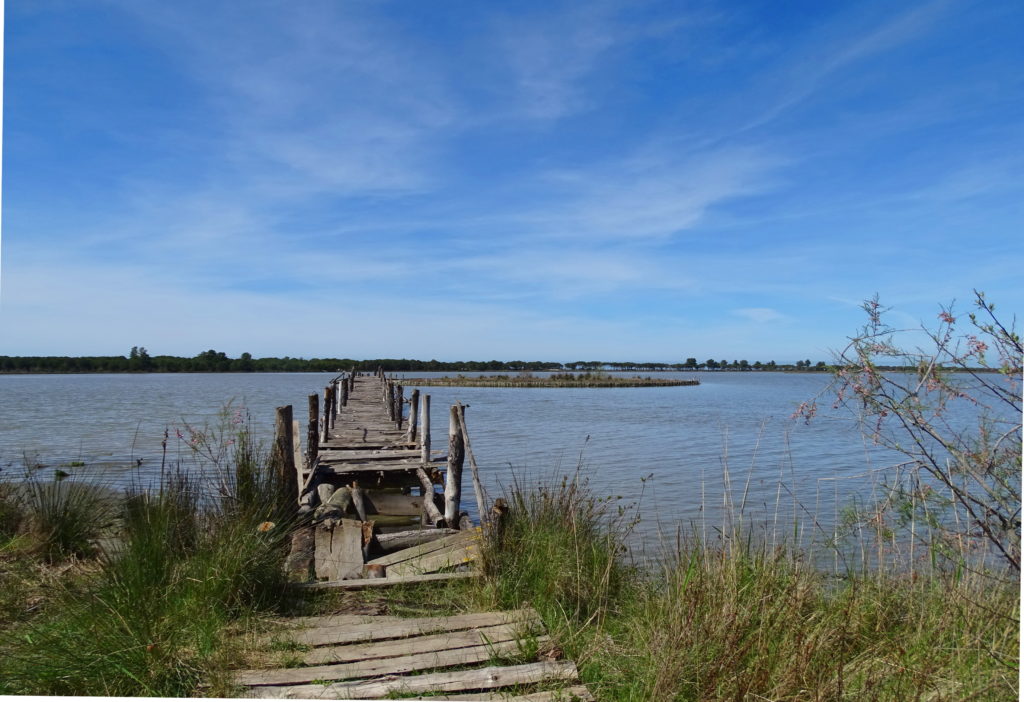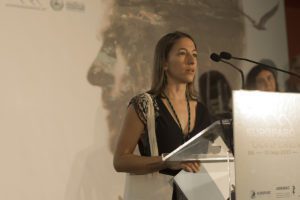Wetland Conservation and Governance – The case of Mar Menor
Article issued by Carmen Martínez, one of the winners of the Alfred Toepfer Natural Heritage Scholarship in 2017. Carmen works for ANSE, a regional ONG aimed at Nature Conservation for more than 10 years working in the region of Murcia, Spain. Carmen is also a Lecturer in Methods Area of Experimental Sciences at Faculty of Education at the University of Murcia. Nowadays, she is engaged in the protection of Mar Menor, a Mediterranean Coastal Lagoon, establishing a management plan and involving inhabitants and workers in its conservation.
Wetland Conservation and Governance – The case of Mar Menor
Sustainable development in protected areas. Contribution to a resource-efficient, green and competitive low-carbon economy
Wetlands are among the most productive ecosystems, but also among the most populated and threatened, due to different pressures such as habitat destruction, drainages, land conversion, pollution and over-exploitation of resources. The Mar Menor lagoon, a hypersaline coastal wetland located in the southeast of the Iberian Peninsula, hosts valuable species and ecosystems, what is legally protected by Regional, European and International figures. Despite its values, the area suffers high pressures due to the high levels of land occupation and intensive uses and, mainly, the lack of a management plan and actions. This causes some changes that triggered a strong and quick eutrophication process in 2016 and, despite some measures have led to the improvement of the water quality, the consequences still endure.
The aim of this initiative was comparing and exchanging information about the coastal wetland management and governance, in order to create certain guidelines and recommendations that help to develop the conservation and sustainable uses of these ecosystems and to propose the export of some of these practices to the Mar Menor lagoon.
During 2018, several protected coastal wetlands from Albania, France and United Kingdom have been visited, thanks to the support of Alfred Toepfel Scholarship, ANSE (Asociación de Naturalistas del Sureste) and WWF/Adena (Spain). The areas were selected due to their similarity to the Mar Menor ecosystem (natural or social), and its different management and governance practices.
The visited areas: where and why?
Divjaka-Karavasta National Park
The Park, located in Albania, has been protected since 1994 and includes a high diversity of ecosystems and species and its landscapes are a reminder of what the Mar Menor lagoon and its associated wetlands would have been one hundred years ago, including some traditional uses as small scale fisheries. Currently, this lagoon has a much lower level of pressure than the Spanish lagoon, although some urbanistic developments that have been programmed will completely change the situation of the park.

Although the local population is not involved actively in the conservation of the area, some environmental organisations fight for the conservation of the park collaborating with the Park Administration, and fight against national administrative and economic decisions, such as the building of a macro resort in the protected area.
The main aims of the visit were to appreciate the involvement of NGOs in the conservation and management of national areas and the relationships between Environmental Bodies, NGOs and Economic Sectors.

The Blackwater, Crouch, Roach and Colne Estuaries
The Blackwater, Crouch, Roach and Colne Estuaries is a low lying estuary that was designated due to its rare habitats and is located in Essex, United Kingdom. Some of the main problems they face are the high levels of land occupation along the river Thames, some pulses of water pollution due to the agricultural practices and the receding of the coastline and the estuary because of climate change effects. Currently, they have fishery management and a management plan for the restoration of the native oyster in the area is being developed, as well as a plan for habitat creation in order to restore the eroding salt marsh. Although they had problems with agricultural runoff in the past, this has been improved these days.
The society of the United Kingdom has a great tradition of associationism. Non-governmental associations have hundreds or thousands of members and volunteers that could urge different Administration to take measures to take care of Nature and improve it. Associations are even able to carry out diverse actions, such as the creation of private reserves or the restoration of habitats in an autonomous way without depending on governmental finance.
The main objectives of the visit were to get some information about people involvement, pollution control, and management and to establish some contacts to help to improve the management of eel fisheries and eel populations.
The French Mediterranean Coast
In the south French Mediterranean coast, several protected wetlands were selected to acquaint various cases studies, experiences and methodologies. These were included in the Réserve Naturelle Nationale du Bagnas, classified as National Natural Reserve and as Natura 2000, where the protection of the space should be balanced with the development of human activities; in the Parc Naturel Régional de la Narbonnaise en Méditerranée, one of the biggest Mediterranean protected spaces in France, water quality is monitored; or in the Parc Naturel Régional de Camargue, a large wetland named Biosphere Reserve by the UNESCO included in the Ramsar Convention, which hosts 7 Natura 2000 places.
The public organisation Conservatoire du Littoral is the owner of some coastal areas of the protected spaces, which predictably ensures the conservation of the area above private interests, and the management of these public areas is carried out by local communities, NGOs or mixed unions, involving people in the area.
The visit intends to discover the advantages and drawbacks of public ownership with participative management and to detect the conflict among different social groups activities and how they have been solved on a consensus basis.
Some measures that could be applied in the Mar Menor lagoon
After these visits, one of the main conclusions is that there are no magic recipes that could solve the problems and there is not a single model for the management of coastal wetlands worldwide, but it should accommodate to the specific necessities and the reality of the space and its surroundings. However, creating some common guidelines and conservation priorities is also essential. Some of the techniques and practices seen in different wetlands that could be implemented in the Mar Menor lagoon are:
- The protected spaces should have a management plan to set up the main criteria and conservation priorities of the space and the way to reach the defined objective, including a governance model. The management plan should be flexible and adaptive to the requirements and changes and be updated periodically. The lack of the plan or management criteria or the lack of adaptability would cause inefficiency in the management process. Currently, the Mar Menor lagoon has no management plan.
- Long-term vision to anticipate changes, such as coastal dynamics, ecosystems succession or climate change effects. Some coastal areas, such as La Manga sandbar, should be prepared for the rising of the sea level.
- Setting inclusive and participative governance models facilitating society involvement at an individual and a collective level.
- Land purchasing of priority spaces of those particularly threatened. Even though this requires a significant investment, the land purchase can facilitate the management, prevent future risks and save costs, which means the benefit surpasses the cost.
- Restoring spaces and decreasing the pressures on threatened areas through innovative actions, aimed to restore the natural functioning of the ecosystem. To have in-depth knowledge of the space, human and economic means is necessary, as well as a courageous attitude to face any opposition.
- Creating boat exclusion areas in order to facilitate the breeding of birds and to improve the status of the flora and seagrasses.
- Fishing management based on the breeding season. Currently, some studies are being carried out by ANSE in order to improve the knowledge of some endangered species as the eel, but some measures should be implemented by Sectoral Bodies.
- Creating spaces for enjoying the Nature with the aim of improving the sense of belonging and the marking with space.

Some general measures and guidelines that could be carried out are:
- External control of the Administration by non-governmental entities that ensure suitable and impartial management, whose main objective is environmental conservation and its balance with the population equitable socioeconomic development. Therefore, it is essential that society acts as a control body, for which it must be motivated and be able to rely on bodies and systems of effective participation.
- The integrity of the natural areas and the ecosystem process should be assured as the only way to get long term conservation and management. The only way of preserving the Protected Spaces is taking into account the natural functioning and the unavoidable changes that will occur over the next decades.
- The deep knowledge of the space, its natural, cultural and socioeconomic reality lets adapt the management to the situation and improves the results. Exchanging good practices set up in other similar areas, intersectoral network building and knowledge are essential for assuring the ecosystem conservation.
- The nature-based solutions could be more efficient than the hard grey infrastructures, but they need better nature and natural process understanding in order to enhance the resilience of ecosystems and the provision of services. The implementation could increase the investment in, mainly, human resources, and the measures taken should be agreed to with the local population and other users.
- The effectiveness of the conservation also depends on the existence of strong institutions, which take agreed measures. Successful management of nature includes well organised cooperation of different institutions involved in nature conservation, enough and evidence-based information on biodiversity and natural process, and appropriate socioeconomic indicators and the courage to establish innovative long-term solutions.
Get to know the previous winners of the Alfred Toepfer Natural Heritage Scholarships and keep tuned, we will open a new call at the beginning of 2020.

Alfred Toepfer Scholarship winners at EUROPARC Conference 2017, Sao Pedro do Sul, Portugal (winners: from left to right: Zerrin Karaarslan, Csaba Bereczki and Carmen Martínez) © Eduardo Realinho

